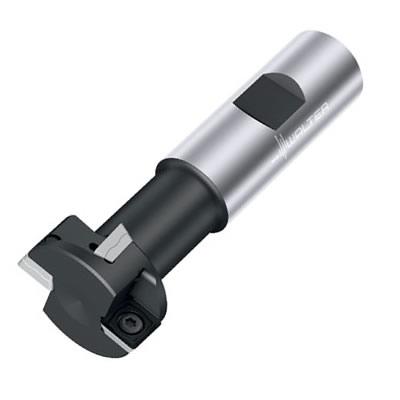
Walter says it has enhanced its M4000 milling cutter system with a new slot drill and a T-slot cutter, enabling users to tackle the vast majority of typical machining operations with a single high-performance yet cost-effective tooling system. The new M4575 T-slot cutter and the new M4792 slot drill join the existing M4002 high-feed cutter, the M4132 shoulder milling cutter and the M4574 chamfer cutter.
A key to M4000 productivity is its innovative insert system which has a single basic shape compatible with every M4000 body, so the inserts can be used in all tools within the M4000 range. This saves on tool and storage costs, and in field tests has reduced cutting tool material costs per component by a half.
In addition to expanding the range of M4000 cutter bodies, Walter is also extending the line's range of indexable inserts. The new WSM45X grade with CVD coating has been added. This grade is suitable for machining stainless steels and difficult-to-cut materials. Together with the Tiger·tec Silver WKP25S and WKP35S grades for steel and cast iron, this addition means that the range now includes a total of three CVD grades. Where a high level of toughness is required, users also have the option of using three PVD grades: WKK25S, WSM35S and WSP45S.
The line's two established geometries have been supplemented with the addition of two new geometries: One for unfavorable machining conditions and high feeds, the other has an anti-vibration geometry for long projection lengths.
Contact Details
Related Glossary Terms
- T-slot cutter
T-slot cutter
Milling cutter for machining T-slots. Desired T-slot shape is reverse of cutter shape.
- chemical vapor deposition ( CVD)
chemical vapor deposition ( CVD)
High-temperature (1,000° C or higher), atmosphere-controlled process in which a chemical reaction is induced for the purpose of depositing a coating 2µm to 12µm thick on a tool’s surface. See coated tools; PVD, physical vapor deposition.
- gang cutting ( milling)
gang cutting ( milling)
Machining with several cutters mounted on a single arbor, generally for simultaneous cutting.
- milling
milling
Machining operation in which metal or other material is removed by applying power to a rotating cutter. In vertical milling, the cutting tool is mounted vertically on the spindle. In horizontal milling, the cutting tool is mounted horizontally, either directly on the spindle or on an arbor. Horizontal milling is further broken down into conventional milling, where the cutter rotates opposite the direction of feed, or “up” into the workpiece; and climb milling, where the cutter rotates in the direction of feed, or “down” into the workpiece. Milling operations include plane or surface milling, endmilling, facemilling, angle milling, form milling and profiling.
- milling cutter
milling cutter
Loosely, any milling tool. Horizontal cutters take the form of plain milling cutters, plain spiral-tooth cutters, helical cutters, side-milling cutters, staggered-tooth side-milling cutters, facemilling cutters, angular cutters, double-angle cutters, convex and concave form-milling cutters, straddle-sprocket cutters, spur-gear cutters, corner-rounding cutters and slitting saws. Vertical cutters use shank-mounted cutting tools, including endmills, T-slot cutters, Woodruff keyseat cutters and dovetail cutters; these may also be used on horizontal mills. See milling.
- physical vapor deposition ( PVD)
physical vapor deposition ( PVD)
Tool-coating process performed at low temperature (500° C), compared to chemical vapor deposition (1,000° C). Employs electric field to generate necessary heat for depositing coating on a tool’s surface. See CVD, chemical vapor deposition.
- stainless steels
stainless steels
Stainless steels possess high strength, heat resistance, excellent workability and erosion resistance. Four general classes have been developed to cover a range of mechanical and physical properties for particular applications. The four classes are: the austenitic types of the chromium-nickel-manganese 200 series and the chromium-nickel 300 series; the martensitic types of the chromium, hardenable 400 series; the chromium, nonhardenable 400-series ferritic types; and the precipitation-hardening type of chromium-nickel alloys with additional elements that are hardenable by solution treating and aging.

